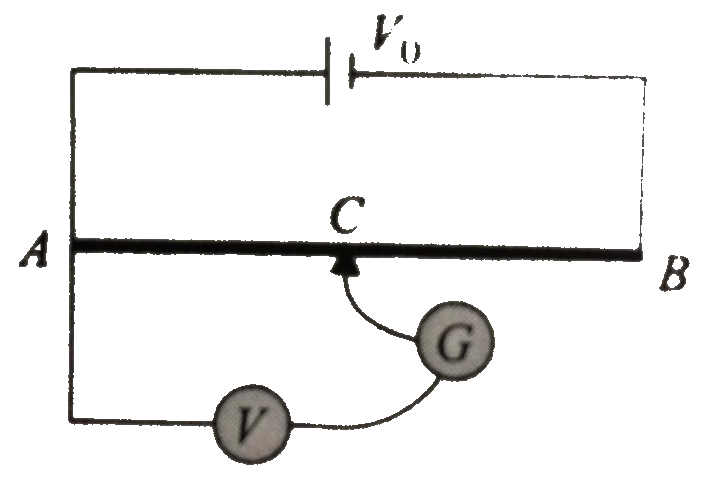All Questions from IE IRODOV PHYSICS Chapter 2 DIRECT CURRENT for Class 12
| Class 12 | PHYSICS |
| Chapter | DIRECT CURRENT |
| IE IRODOV PHYSICS | All Questions |
| Medium | English |
| Academic Year | 2023-2024 |
Question 2
A voltage V0 is applied to a potentiometer whose sliding constant is exacly in tne middle. A voltmeter V is connected between the sliding constant and one fixed end of the potentionmeter. If is assumed that the resistance of the voltmeter is not very high in comparison to the resistance of the potentiometer wire. What voltage will the voltmeter show : higher than, less than, or equal to V0/2?
 View Solution
View SolutionQuestion 3
To measure a small emf (of, say, a galvanic cell or a thermocouple) the so-called balancing method is employed. The circuit diagram of this method is shown in the figure. Here ~x is the sought emf, is the source of current whose emf is much higher than ~x, G is a galvanornetcr with the zero in the middle of the scale, A is an ammeter, and R is the resistance box. How should one operate this circuit so as to ensure an accuracy in measuring ~x that is determined by the precision of the measuring devices?View SolutionQuestion 4
Two resistors with resistances R1andR2 are connected in series, and so are two capacitors wi th capacit ances C1andC2. The two systems arc connected in parallel and an external voltage is applied to the new system (see the figure accompanying the problem). What must be the relationship between R1,R2,C1,andC2 for the potential difference between the points aandb to be zero?View SolutionQuestion 5
All the resistances and ernfs shown in the figure accompanying the problem are assumed known. How many values of current can exist for such a circuit ? How many equations for finding these values must we construct on the basis of Kirchh off's first law and how many must we construct OIl the basis of Kirchh off's second law'?View SolutionQuestion 6
Twelve conductors are connected in such a way that they form a cube, and an emf source is co nnertr d into an edge of the cube. All the resistances and the emf's are known. There are eight junctions (eight vertices of the cube) and six loops (six faces of the cube) in the circuit. Construct tho equations for determining all the currents in the circuit.View SolutionQuestion 7
A source of electric current with an emf ∈o and an Internal resistance r is connected to an external circuit with a resistance R. What must be the relationship between rand R for the power output in the external circuit to be maximal? What is the efficiency of the current source in this case, provided Lhat the power output in the external circuit is assumed to be the useful out put?View SolutionQuestion 9
A charged capacitor is discharged through a resistor two times. The time dependence of the logarithm of the discharge current obtained in the two experiments is represented by the two straight lines 1and2, in the figure accompanying the problem. The experimental conditions differed only in one of the three parameters: the initial voltage of the capacitor U, the capacitance C, or the resistance R. Determine the parameter that was varied in these experiments and in which case this parameter is greaterView SolutionQuestion 10
The energy distribution function for electrons in a metal at absolute zero can be written as follows: f(W)=CW12, where C is a constant coefficient that is a combination of universal constants. This function terminates at WF, which is the limiting energy, or the Fermi level. Using (4.36.1), establish how the limiting energy depends on electron concentration.View SolutionQuestion 13
The distribution of potential near the boundary between two semiconductors with different types of conduction depends on the direction of the applied external voltage. Which distribution corresponds to the blocking direction and which, to conduction? To what semiconductors do the left and right branches of the curves in the figure belong ?View SolutionQuestion 14
The phenomenon of secondary eiectron emission consists in the following. When electrons bombard a solid surface, the surface emits secondary electrons (and partially reflects the primary electrons, which Impinge on the surface). Secondary electron emission is characterized by the secondary emission coefficient δ, Which is the ratio of the secondary electron current to the primary current. The dependence of the secondary emission coefIicient on the primary electron energy W1 for a certain dielectric is depicted in the figure. At δ=1 the surface of the dielectric does not change its potential under electron bornbardment, since the number of electrons leaving tho surface every second is equal in this case to the number of electrons bombarding the surface every second. The two points aandb on the δvs.W1 curve correspond to δ=1. At which point is the process stable and at which is it unstable?View SolutionQuestion 15
Under secondary electron emission (see Problem 4.41), the energy distribution function F(W2) for secondary electrons is represented sufficiently well by two curves (1and2) shown in the figure accompanying the problem. Which of the two curves represents the primary electrons and which, the "true" secondary electrons?View Solution